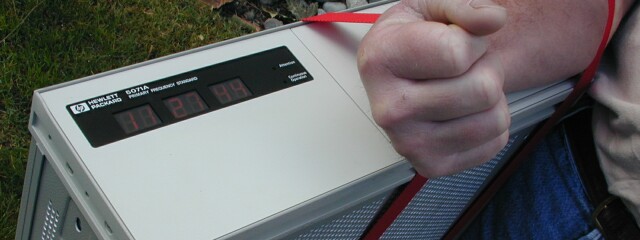
Do not be misled. The many "atomic time" wristwatches you see on the market today are merely cheap quartz wristwatches with a built-in radio receiver. The watch sets itself from 60 kHz VLF radio time signals transmitted by NIST from station WWVB near the US atomic clock in Boulder, Colorado. At least once a day, reception permitting, usually at night, the watch resets itself to compensate for the normal drift of a quartz crystal. The result is a self-setting, radio-controlled, atomic-time, wrist watch that is never off by more than a second or two a day. Impressive and convenient. But these are not atomic clocks.
Today we have the first true atomic wristwatch.
The definition of a wrist watch is a time piece that can be worn on the wrist, no? Below is my brother-in-law, Bill, a professional construction contractor, proving that a HP 5071A Cesium Beam Primary Frequency Reference can in fact be used as a wrist watch. You have a choice in stainless steel or adjustable nylon band. Bill's model below has a fashionable double nylon band. Other colors are available by special order.
The watch keeps time to a few nanoseconds per day. The attractive display is based on 7-segment red LED technology. Batteries are included (they last about 45 minutes but are rechargeable). AC adapter included. There are no adjustments for daylight saving time; however the clock does handle leap seconds and keeps track of the [Modified Julian] date. This HP wristwatch includes 5/10 MHz and 1 PPS outputs. An internal keypad is used to set the date and time. Not waterproof nor even water resistant. High-performance models available. Contact your Symmetricom [1] sales office for details.
Bill checks the time on his Atomic Wristwatch:

Detail of nylon band:

Detail of watch face - model Hewlett Packard 5071A:

So there you go. The most accurate wrist watch. The first 5071A wristwatch. ;-)
[1] The Hewlett Packard cesium frequency product line was inherited by Agilent Technologies in 1999 and then acquired by Symmetricom in 2005.